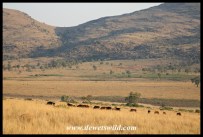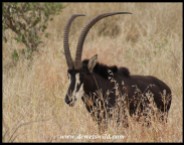Hippotragus niger
To us, the Sable is the most majestic of all the antelope – the proud bulls with their gracefully curved horns, pitch-black bodies and contrasting white stomachs make a sight to behold! The Sable is a large antelope, weighing from 180 to 270 kg and standing up to 1.4m high at the shoulder. Bulls are only slightly larger than the cows.
The Sable Antelope inhabits open woodland and savannas, with medium to long grass, large trees and few shrubs. They are seldom far from water as they need to drink daily. They are almost exclusively grazers, consuming only small quantities of leaves and herbs, especially in the dry season.

Sable Antelope (photo by Joubert)

Sable Antelope cows

Sable Antelope

Sable Antelope bull
Adult bulls maintain territories through ritual display and serious fights, and attempt to keep passing herds of cows and their calves in their area so that they can mate with receptive females. Breeding herds number about 20 animals, though larger, temporary groups of up to 200 may form in areas of good grazing. Males that aren’t able to hold territories come together in small bachelor herds. A strict hierarchy applies in both the bachelor and breeding herds, and appears to be based on age – the older the animal the higher its rank. Sable Antelope are most active in the early mornings and evenings, sometimes into the night, and rest in the shade during the heat of the day. Sable can be very dangerous and defend themselves valiantly against predator attacks – when cornered they will back into a thorny bush and face the attacker head-on with powerful swipes of those magnificent horns – even lions have been killed by Sable!
Most Sable calves are born in the rainy season, after a gestation of about 9 months. Cows leave their herds a few days before their calves are born and the calf then stays hidden for 2 to 4 weeks, during which time the mother nurses it twice daily, before joining up with the herd again. Young bulls are expelled from the herds at about three years of age to join bachelor groups, until they can establish their own territory at 5 – 6 years of age. Females remain in their maternal herds. Lions and crocodiles are the only natural threat to adult Sable Antelope, but leopards, cheetahs, spotted hyenas and wild dogs take a heavy toll on calves, especially while they are kept hidden those first few weeks of life. Sable have a life expectancy in the wild of between 10 and 18 years.
With a relatively stable population of 75,000 distributed from southern Kenya to northern South Africa, the IUCN considers the Sable Antelope as being of least concern overall, with at least half of this population occurring in protected areas. Outside of formal conservation areas they are becoming increasingly rare due to hunting and loss of habitat. An isolated population in Angola, known as the Giant Sable (H.n.variani) numbers only between 200 and 400 and is considered critically endangered. In South Africa, Namibia and Zimbabwe the Sable is regarded a valuable game ranching animal (mostly for trophy hunting) and as a result has been introduced widely onto private land, also outside their historical distribution range, representing the only sub-populations that are actually increasing in number and now make up about a quarter of the total population. South Africa’s biggest natural population occurs in the Kruger National Park, where their numbers have dropped significantly over the years due to competition from other herbivores. They can also be seen, amongst others, at Marakele, Mokala and Pilanesberg National Parks, at Loskop Dam and Willem Pretorius Game Reserves and in the Kgaswane Mountain Reserve.

Sable Antelope

Kgaswane scenery towering above a herd of sable antelope

This time we had good views of the magnificent sable antelope for which Kgaswane is so well known

This time we had good views of the magnificent sable antelope for which Kgaswane is so well known

This time we had good views of the magnificent sable antelope for which Kgaswane is so well known

Sable antelope in the distance

Sable Antelope females and calves

Sable Antelope cow

Sable Antelope bull and cow

Sable Antelope

Sable Antelope

Sable antelope

Sable antelope

Sable Antelope calf

Sable Antelope bull and harem

Sable Antelope on the S36 between Tshokwane and Talamati

Sable Antelope

Sable Antelope

Sable Antelope

Sable Antelope

Sable Antelope

Sable Antelope cow

Sable Antelope bull

Sable Antelope bull

Sable Antelope bull

Sable Antelope

Sable Antelope

Sable Antelope

Sable Antelope

Sable Antelope

Sable Antelope






























































